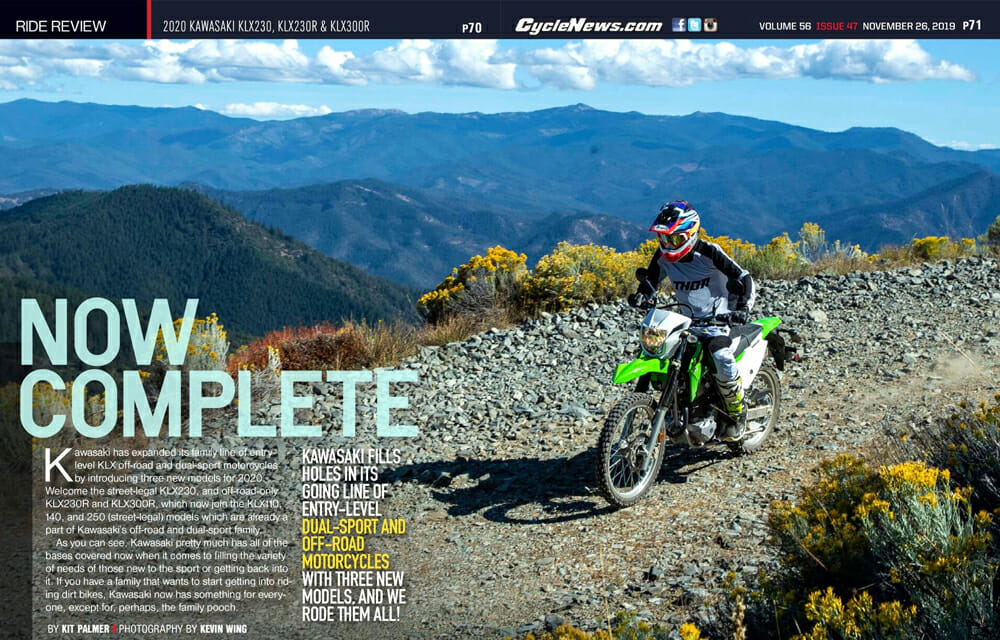The Kawasaki KLX300 is a new motorcycle but it already has some history.

Photography by Kevin Wing
Kawasaki has expanded its family line of entry-level KLX off-road and dual sport motorcycles by introducing three new models for 2020. Welcome the street-legal KLX230, and off-road-only KLX230R and KLX300R, which now join the KLX110, 140, and 250 (street-legal) models which are already a part of Kawasaki’s off-road and dual-sport family.
As you can see, Kawasaki pretty much has all of the bases covered now when it comes to filling the variety of needs of those new to the sport or getting back into it. If you have a family that wants to start getting into riding dirt bikes, Kawasaki now has something for everyone, except for, perhaps, the family pooch.

2020 Kawasaki KLX300 Review
The Kawasaki KLX300 is a new motorcycle but already has some history. It’s been more than a decade since we’ve seen the last full-size 300cc dirt bike from Kawasaki, and the new KLX300 can trace some of its roots back to the ’90s, but it features several important technological advances over the older 300, such as electric starting and EFI. And it has modern looks, too.

The KLX300 is fitted with a 292cc, liquid-cooled, DOHC, four-stroke engine with a six-speed transmission, just like in the old days.
Compared to the new 230R, the 300’s suspension is significantly advanced. The 300 is equipped with a higher-tech gas-charged, piggy-back reservoir shock that rides on linkages (as do the other two bikes) and is fully adjustable. Up front is a beefier inverted 43mm fork that includes adjustable compression damping. (The 230 has no such thing, front or rear.) And the 300 has a little over an inch more wheel travel at both ends over the 230.

The 300R has larger front and rear disc brakes than the 230R and a tick taller seat height (36.4 inches versus 36.2 inches). The 300 also holds .4 gallons more fuel than the 230 at 2.1 gallons. Tires and wheels are the same.
But before you immediately plop down your cash on the 300, you must keep in mind that the 300 does weigh almost 30 pounds more than the 230 and costs $1100 more at $5499. Some things to think about, for sure.
As expected, the 300R a more capable off-road bike than either the 230 and 230R. In fact, it’s downright good. The suspension does an excellent job soaking up the bumps and doesn’t bottom as easily as you’d think. Fully geared up, I weigh around 170 pounds and was able to attack the whooped-out single-track trails in the Oregon mountains where I rode the 300 (and 230s) with confidence. Based on the spec sheet, the 300R is close to being a full-size motorcycle, too, but still felt quite small under me; even so, I never felt severely cramped or uncomfortable on the bike.

It makes good power overall, pulls nicely off the bottom, and gets you up to speed quickly enough and efficiently. It’s an extremely easy motorcycle to ride. Despite its seemingly large displacement, the KLX300R will still make for an excellent entry-level motorcycle. There is nothing scary or intimidating about this bike, yet it still packs enough punch to keep experienced trail riders that aren’t in a big hurry quite happy. In fact, in extremely tight, technical, and nasty trails, the KLX300R could be the bike of choice because of its small-ish overall size, user-friendly motor and decent suspension. Making things even more appealing, the 300 has powerful brakes, and a versatile six-speed transmission with a seemingly strong clutch, and with its 2.1-gallon fuel tank, you’ll hardly ever have to worry about running out of fuel. There is plenty to like about the KLX300R.

Kudos to Kawasaki for doing an excellent job filling in the gaps in its off-road/dual sport entry-level line with the KLX230, and 230 and 300Rs. Anyone looking to get into dirt bike riding for the first time or getting back into it again should put these three very good motorcycles on their shopping list.CN

2020 Kawasaki KLX300 Specifications
| MSRP: | $5,499 |
| Engine: | Liquid-cooled, 4-stroke, DOHC, single |
| Displacement: | 233cc / 233cc / 292cc |
| Bore x Stroke: | 78.0 x 61.2mm |
| Compression Ratio: | 11.0:1 |
| Fuel System: | DFI w/34mm Keihin throttle body |
| Transmission: | 6-speed |
| Frame Type: | Steel, tubular, semi-double cradle |
| Front Suspension: | 43mm inverted telescopic fork w/ compression damping adj. |
| Rear Suspension: | Uni-Trak linkage w/ adj. spring preload, compression & rebound damping adj. |
| Front Wheel Travel: | 11.2 in. |
| Rear Wheel Travel: | 11.2 in. |
| Front Tire: | 80/100 x 21 in. |
| Rear Tire: | 100/100 x 18 in. |
| Front Brake: | Single 270mm petal disc w/dual-piston caliper |
| Rear Brake: | Single 240mm petal disc w/ single-piston caliper |
| Rake: | 26.9° |
| Trail: | 4.3 in. |
| O/A Length: | 83.5 in. |
| O/A Width: | 32.5 in. |
| O/A Height: | 49.2 in. |
| Wheelbase: | 56.5 in. |
| Ground Clearance: | 12.0 in. (11.8 in. CA model) |
| Seat Height: | 36.4 in. |
| Curb Weight (claimed): | 282.2 lbs. (286.6 lbs. CA) |
| Fuel Capacity: | 2.1 gal. |

Click here to read the 2020 Kawasaki KLX230 Review, along with the 2020 Kawasaki KLX230R Review and 2020 Kawasaki KLX300R Review, in the Cycle News Digital Edition Magazine.
Click here for the latest Cycle News Dual Sport motorcycle reviews and news.
Click here for the latest Cycle News Off-Road motorcycle reviews and news.
Click here for more Kawasaki motorcycle reviews and news.
